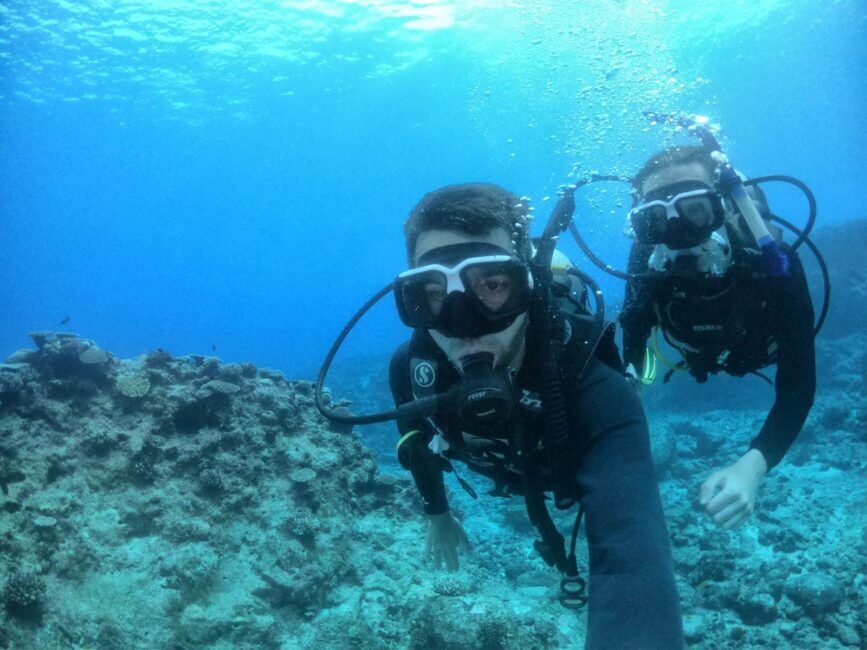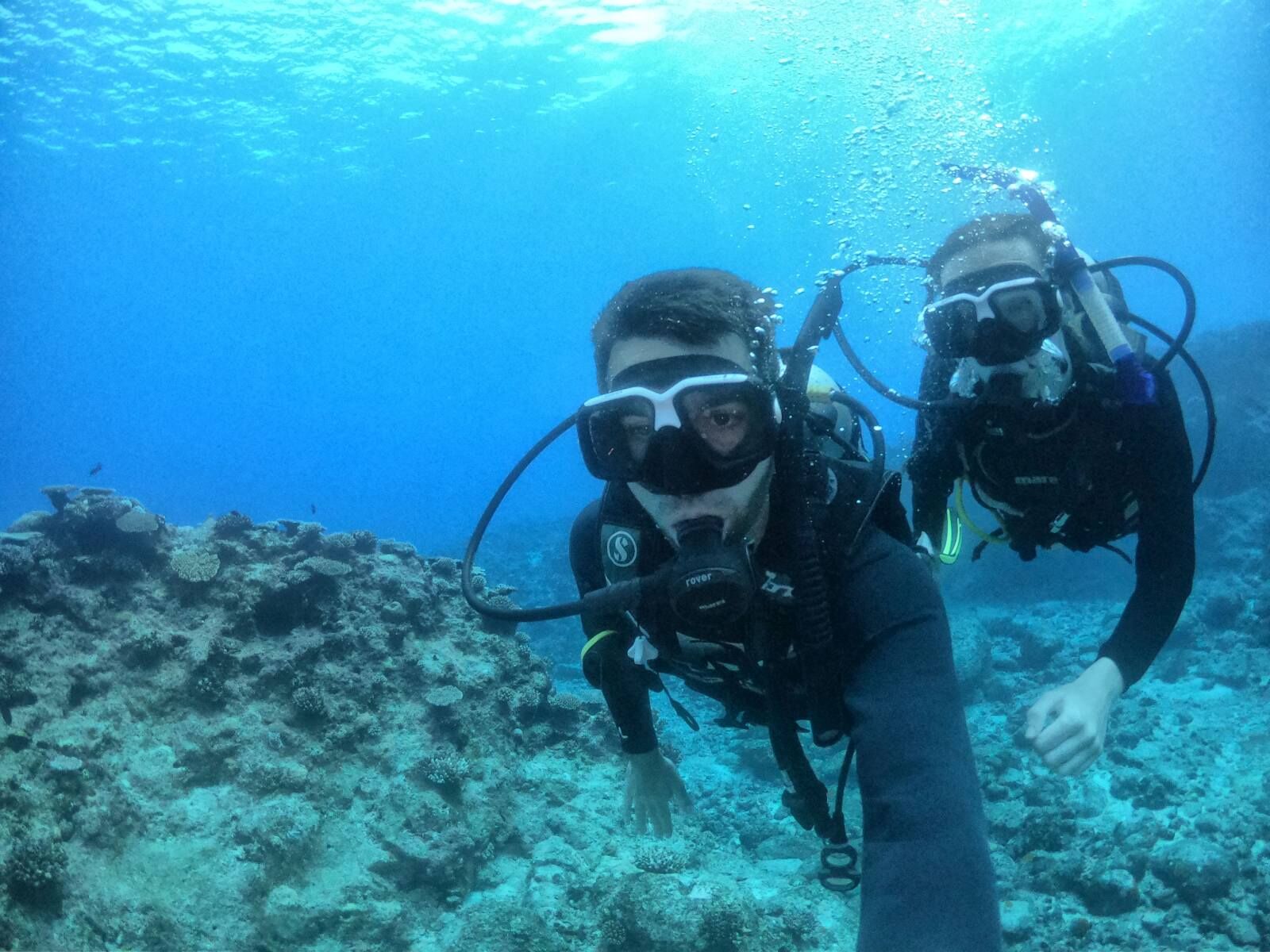The Scuba Diving Seasons in Rarotonga and the Cook Islands
Unlike many places in the world, the Cook Islands doesn’t have a “bad” time to scuba dive. The visibility is pretty darn good all year round, averaging around 30m (100ft) in both summer and winter. However, if you want the conditions a little bit clearer, warmer or are perhaps wanting the opportunity to see humpback whales, then there will be the best time to scuba dive in Rarotonga and the Cook Islands for you. Get more advice on the Cook Islands diving seasons in the guide below.
Before we “dive” into the guide to the best time to dive in the Cook Islands, be sure to compare other variables, such as tourist season, weather and events, in The Best Time to Visit Rarotonga & the Cook Islands: A Month by Month Guide.
5 Facts About Scuba Diving in the Cook Islands
- The water temperature in the Cook Islands is 24-27°C (75-81°F) year-round for comfortable diving
- The visibility is rarely less than 20m (65ft) but more commonly 30-60m (100-200ft)
- The Cook Islands has limited dive shops, so book your spot well in advance! Check them out in the 5 Best Dive Shops in the Cook Islands
- Rarotonga and Aitutaki have an array of amazing dive sites, which you can check out in the Top 10 Places to Scuba Dive in the Cook Islands
- Sights on dives can include turtles, eagle rays and giant trevally and around 73 types of coral and hundreds of species of fish.
Winter Diving in Rarotonga and the Cook Islands
The Cook Islands’ winter season, also known as the dry season, runs between April and November. However, winter in the Cook Islands is far from “wintery” with sea temperatures typically around 25°C (77°F) and air temperatures between 19 and 27°C (66-81°F). A 5mm full-length wetsuit is usually comfortable for these winter months, along with a warm layer for the breezy albeit quick boat rides after getting out of the water.
Water Visibility in Winter
The winter gets its “dry season” name due to the less precipitation that the South Pacific receives during the months of April to November. The average rainfall is around 206mm (8.1″) per month and sees less surface run-off into the ocean. This often results in some of the clearest waters the Cook Islands experiences, often being 30m+ (100ft) up to as much as 60m (200ft) on some occasions!
Scuba Diving with Whales
One of the other major advantages of diving in the winter season in the Cook Islands is the possibility of spotting humpback whales. Whales can only be found in the Cook Islands’ waters between July and October where dive sites particularly on the northern and western coast of Rarotonga are good places to increase your chances of spotting one. Learn more about the whales in Cook Islands Whale Season: The Best Time to See Whales in the Cook Islands.
Learn more about the seasons in the Cook Islands in The Cook Islands Weather, Seasons & Climate + Weather by Month. Plus, get more advice on planning a scuba trip to the Cook Islands with The Best Scuba Diving in the Cook Islands: Top 10 Places to Scuba Dive.
Summer Diving in Rarotonga and the Cook Islands
Summer in the Cook Islands runs from December to March and is also known as the wet season. This time is usually hotter and more humid in the Cook Islands, making scuba diving a pretty relieving experience from the heat. Sea temperatures are typically around 26°C (79°F), while air temperatures are between 23 and 29°C (74-84°F). A 3mm full-length or a shortie wetsuit is usually suitable for these months.
Water Visibility in Summer
December to March also falls into the wet season and the cyclone season in the South Pacific, where the average precipitation per month is 238mm (9.4″) and there are times of higher winds. As a result, these months tend to have slightly less water visibility, but still average around 30m (100ft) and rarely drop below 20m (66ft).
Prevailing Winds
Another effect the summer season has on diving is that the prevailing southeasterly winds are more likely to cut off diving sites on the southeast sides of the island. Nevertheless, on days when it is too dangerous to dive outside of the lagoon, the dive sites within the sheltered lagoons of Rarotonga and Aitutaki provide a worthy backup.
Tourist Low Season
An advantage of a scuba diving trip in summer in the Cook Islands, however, is that the islands are much less busy than in winter. This means that you’ll likely have your first choice of accommodation, there are usually discounts on accommodations and sometimes even flights, and having entire dive sites to yourself (and your buddy/dive instructor, of course). More advantages for travelling at this time of the year can be found in the 10 Reasons to Travel in the Low Season in Rarotonga & the Cook Islands.
More About the Best Time to Dive in Rarotonga and the Cook Islands
That’s it for the best time to dive in Rarotonga and the Cook Islands but not the end of our scuba diving advice! Check out the following guides for bubbles of fun!
- Learn to Dive in the Cook Islands: A Guide to Scuba Diving Certifications
- 5 Best Dive Shops & Operators in Rarotonga & the Cook Islands
- The Best Scuba Diving in Rarotonga: Top 25 Places to Scuba Dive
Finally, plan the rest of the logistics of your scuba diving trip to the Cook Islands by using The Best Cook Islands Travel Guide, as well as our Trip Ideas category full of itineraries.
Author
Robin C.
This article was reviewed and published by Robin, the co-founder of Cook Islands Pocket Guide. He has lived, worked and travelled across 16 different countries before settling in the South Pacific, so he knows a thing or two about planning the perfect trip in this corner of the world. Robin works and consults regularly with Cook Islands Tourism Corporation, a local government body representing the tourism industry. Robin is also the co-founder of several other South Pacific travel guides and is a regular host of webinars with the South Pacific Tourism Organisation.

